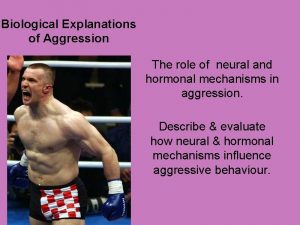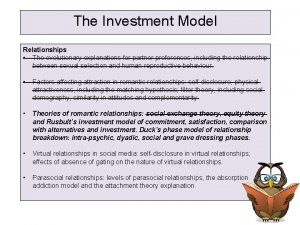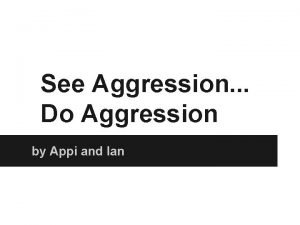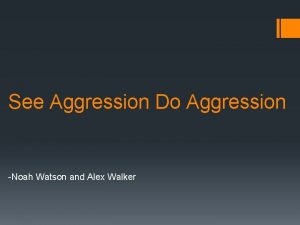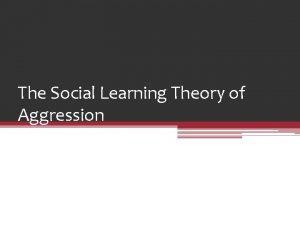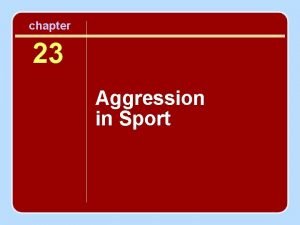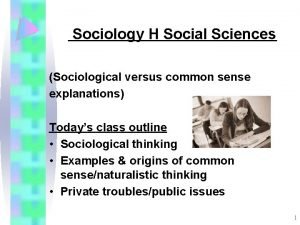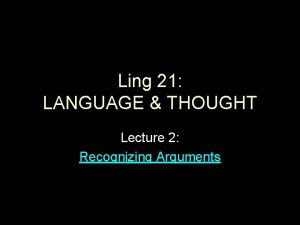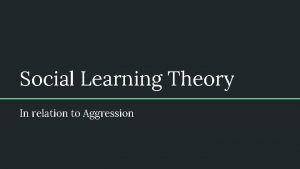Evolutionary explanations of aggression Jealousy and Infidelity Learning










- Slides: 10

Evolutionary explanations of aggression Jealousy and Infidelity

Learning Objectives To outline the evolutionary explanation of human aggression To link this aggression to infidelity and jealousy To evaluate this explanation using research

What are the main assumptions of the evolutionary perspective?

How might aggression be an adaptive response?

How might aggression be an adaptive response? Gain territory and resources i. e. children bullying others for money or toys, adults mugging and warfare. Defending against attacks: aggression to prevent loss of resources i. e. “stick up for yourself. Attacking same sex rivals: aggression between same sex members to aid in the competition for resources and mates i. e. men fighting over women. Negotiating status and power hierarchies: aggression to gain respect and dominance i. e. gang violence to “prove oneself” Deterring rivals from future aggression: aggression to maintain dominance and fear in others i. e. making threatening gestures, maintaining an aggressive appearance Deterring mates from infidelity: aggression against opposite-sex members to maintain faithfulness of long-term mates and ensuring paternity i. e. wifebattering

How is sexual jealousy an adaptive response? The act of or fear of infidelity (cheating) triggers an emotional state (jealousy) as it is perceived as a threat to the relationship This naturally leads to the showing of behaviours that would reduce and eliminate threat A man can never be certain that he is the father of his wife’s children unless he prevents her having relationships with other men. This can explain why male sexual jealousy is often cited as a cause of domestic violence. CUCKOLDRY – a man may unknowingly invest resources in rearing children that are not his own

Infidelity and jealousy Sexual jealousy is thought to be one of the main causes of aggression/violence Use the hand-out to outline the link between mate retention techniques and violence Make use of at least 2 pieces of research

Why do men and women express jealousy differently? What evidence is there of this? MALES - Human males cannot risk wasting investment on offspring who are not their own so they show more jealous violent aggression - both towards the male competitors and their long-term female mates FEMALES - If a male is unfaithful the female partner risks losing his commitment to her children. Human females can always guarantee that their offspring are their own and compete with other females for the quality of men rather than for the availability. Women take fewer risks with violence and use more indirect forms of aggression.

Research evidence Male-male aggression Cross-culturally, human violent aggression and homicide is far more common in males, against other males (Daly and Wilson, 1988). Sexual jealousy produces more male homicides than female-female. Female-female aggression Female aggression is more verbal against other women to maintain status and reduce the attractiveness of competitors, especially by using verbal criticism of the physical unattractiveness of other females to lower their appeal in the eyes of men (Buss and Dedden, 1990).

Evaluation STRENGTHS PRACTICAL APPLICATIONS. . . The use of mate-retention techniques are an early sign that the relationship may lead to the use of violent behaviour. Research support WEAKNESSES Research - Use of surveys to collect data? ? Fails to explain why some people react in one way to a situation while other produce a different response IDA – biases? Issues? Debates?
 Biological explanations of aggression
Biological explanations of aggression Investment model relationships
Investment model relationships See aggression do aggression
See aggression do aggression See aggression do aggression
See aggression do aggression Infidelity of leonor rivera
Infidelity of leonor rivera Stages of infidelity recovery
Stages of infidelity recovery Kidlat club rizal
Kidlat club rizal Social learning theory of aggression
Social learning theory of aggression Aggression definition in sport
Aggression definition in sport Examples of common sense and sociological explanations
Examples of common sense and sociological explanations Premise indicators
Premise indicators
